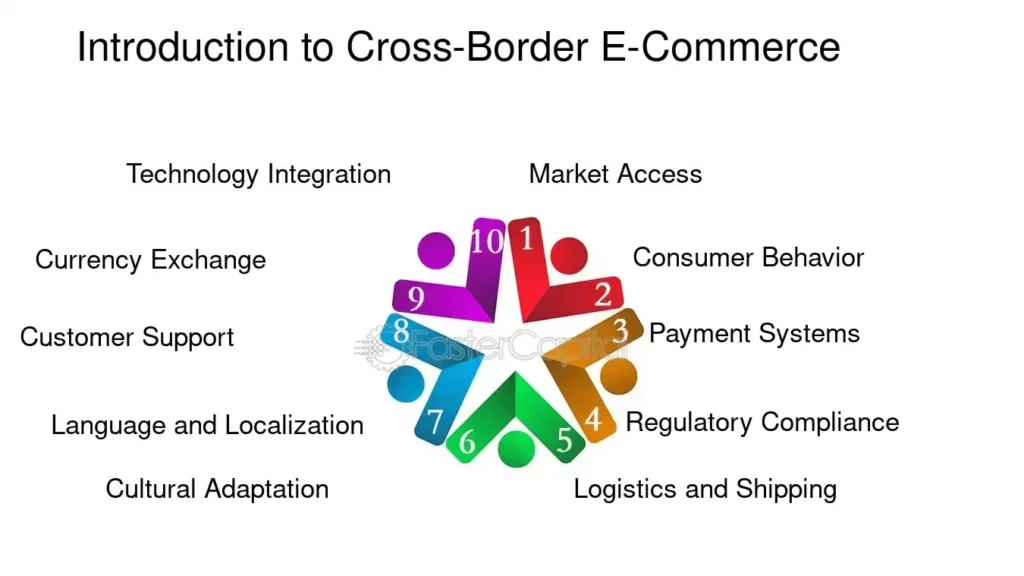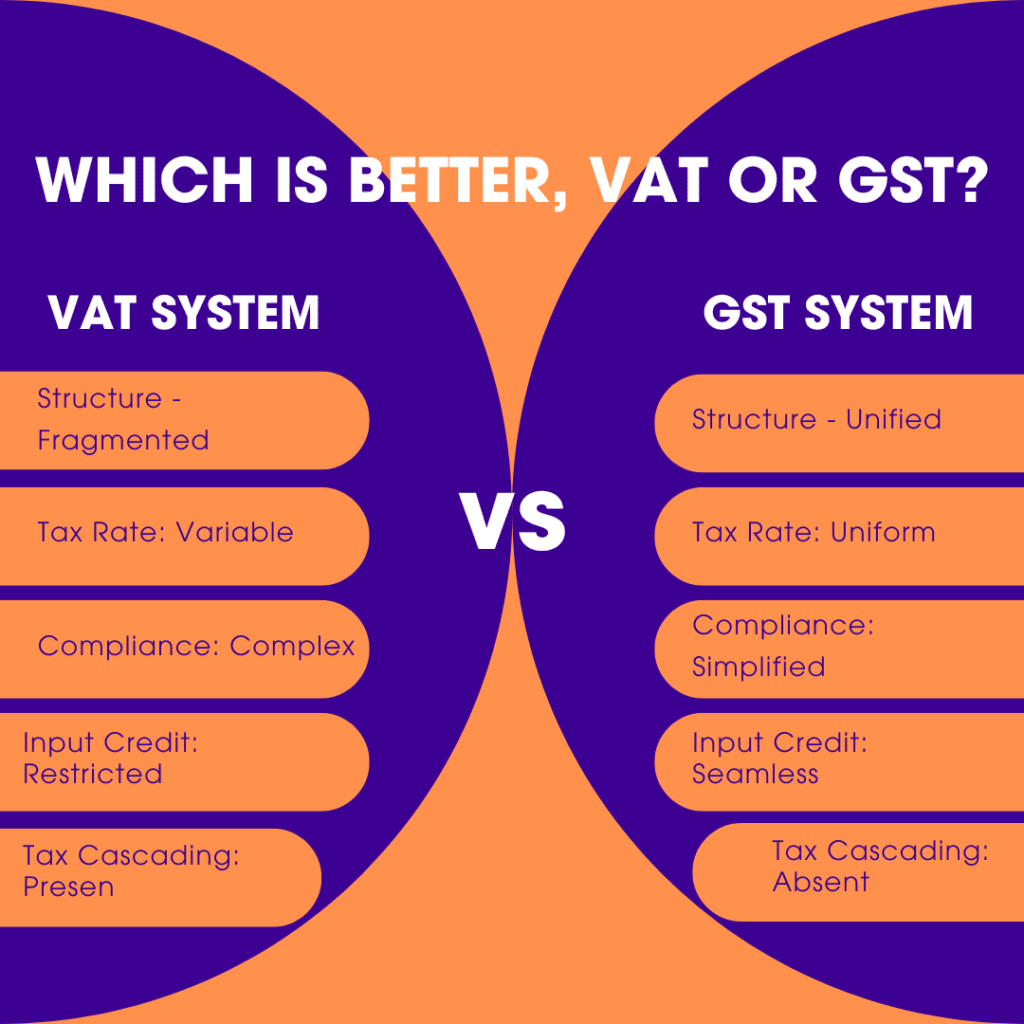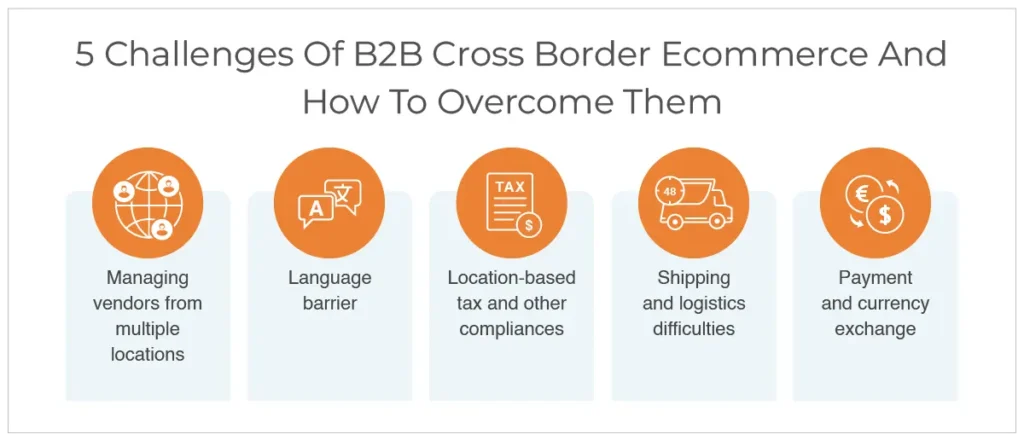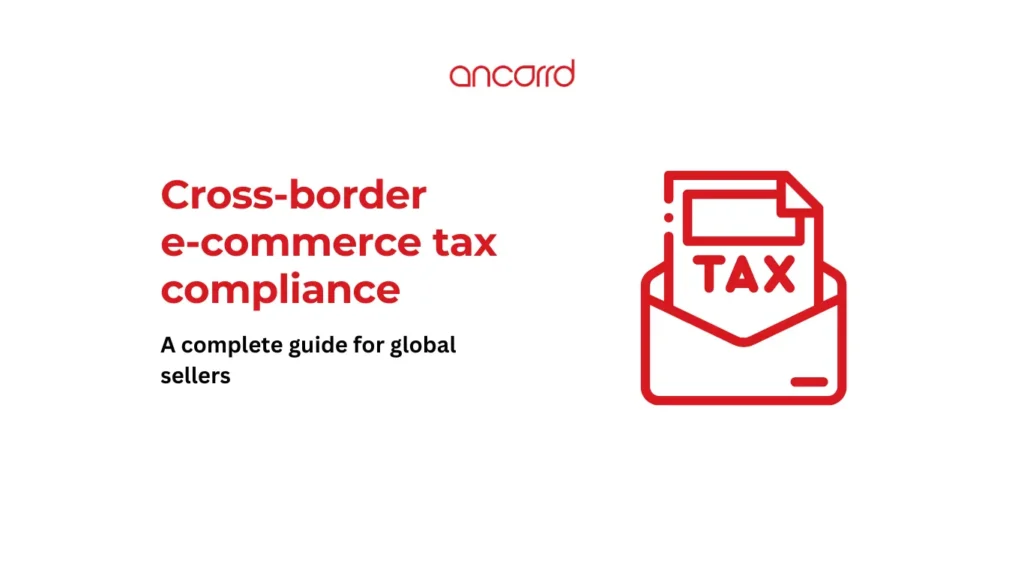Nowadays, e-commerce brand owners penetrate multiple markets in various countries and want to provide everyone with the same customer service.
As a business owner, if you are considering expanding your e-commerce business to other countries, the elephant in the room will be different tax systems, customs duties and tariffs, and international taxes. This is because all the countries have their respective tax systems. You must keep abreast of the latest tax systems and rules to expand your business to other countries.
This blog aims to provide all the necessary information before expanding your business overseas. You will find information on different types of taxes, the main challenges, and their solutions. Let’s dwell on cross-border e-commerce tax systems.

What is cross-border e-commerce tax?
Cross-border e-commerce tax is the amount businesses pay to sell products or services to a customer in another country. Different countries have different types of taxes based on their judiciary system. There are two main categories of taxes:
Direct taxes
Direct taxes comprise corporate taxes imposed on businesses for profits. This is one form of international tax compliance.
For instance, if your e-commerce store operates from a country and incurs a profit from sales in another country, you could be obliged to pay corporate taxes there.
It’s like if you are selling a product in Canada while sitting in the USA. Then, according to Canadian rules, you have to pay a direct tax to Canadian officials. They will deduct a certain amount from your profits.
Indirect taxes
International tax compliance regulations also include Indirect taxes, such as VAT and GST, that are charged on the sale of products or services.
These taxes are collected in addition to what a customer pays. They are called indirect taxes because they are not deducted from your profit but collected from intermediaries.
These taxes are included in the product price and are ultimately paid by the customer. However, an intermediate authority, such as a seller or service provider, pays them to the government.
Imagine you are selling a beauty product in New Zealand that costs $30 while sitting in America.
Almost $2-5 will be an indirect tax on that product, which the customer will pay, but your seller will collect it and pay it to the government. This is how cross-border e-commerce tax works.

Domestic vs. international tax structure
Taxes from domestic sales are relatively easy to track since a seller only needs to follow local rules. However, for sales across borders, the cross-border e-commerce tax structure varies widely from one country to another.
Some countries have sellers’ registration for VAT and GST or strict customs duties against imported commodities.
Why should one learn about cross-border e-commerce taxes?
A proper understanding of how cross-border e-commerce taxes work is important for the following reasons:
- Avoiding Penalties: Failure to comply with tax laws can result in fines or even bans from certain markets.
- Optimization of Profits: Tax planning helps avoid unnecessary expenses.
- Building Trust: Compliance with tax rules portrays professionalism and builds customer confidence in your brand. Countries also impose consumer protection laws so that the price of the product may not be out of reach by the consumer after all the taxes are added.
Main types of taxes for cross-border sellers
When selling across borders, several types of taxes are present. International tax compliance regulations have made a lot of rules regarding e-commerce businesses trading in other countries. Let’s break it down in simple terms below:
1- Value-added tax (VAT)
Value-added tax is a tax on the value added to a product at every step of its production or distribution. For e-commerce sellers, VAT is usually added to the product’s final price and paid by the customer.
- Where It Applies: VAT is very common in the European Union, the UK, and the rest of the world.
- How It Works: Suppose you sell products to customers in the EU. You must then register for VAT in the countries you sell to. Once registered, you collect VAT from your customers and pay it to the local tax authorities.
- VAT Thresholds: Most countries have VAT thresholds, meaning you are only required to register for VAT if your sales exceed a certain amount. For instance, the EU’s VAT threshold for cross-border sellers is €10,000.

2- Goods and services tax (GST)
GST is a kind of VAT and is applied to goods and services sold within certain countries.
- Where It Applies: Countries like Canada, Australia, Pakistan, and India use GST systems.
- How it Works: Just like with VAT, you have to register for GST if your customers hail from these countries. You add the GST on your products and will pay this to the country’s local government.
3- Customs duty
Customs duties and tariffs refer to taxes levied against merchandise once it crosses borders between two countries. The taxes range with products of what nature, value, and in the destination country.
- How It Works: Suppose you sell some clothes to a client in the USA. When your package arrives in the USA, there is a probability that the customs authorities charge a customs duty and tariff based on the value of the clothes. That duty can either be paid by you or passed down to the customer.
- How It Impacts Your Pricing: The general cost of your product can rise due to customs duties; therefore, ensure that it finds its way into your pricing strategy. You also need to keep in mind the consumer protection laws while pricing your products.
4- Seller’s income tax
When earning income from sales in other countries, you will incur income tax in such foreign countries.
- Double Taxation: In some cases, companies are double charged on the profits, taxed within the seller’s home country and the foreign market. This is one of the disadvantages of International tax compliance regulations.
- Tax Treaties: Several tax treaties have been established among these countries to exempt businesses from these taxes, as they should be taxed only in one country.
Cross-border e-commerce tax regulations by region
Selling products across borders is subject to various tax laws by international tax compliance regulations which vary by region. These regulations impact pricing, profitability, and compliance. Here is a general summary of the major tax regulations in various regions:
1- North America (USA and Canada)
Sales tax in the USA is handled by states. Different states have their respective tax rates, and a few of them, such as Delaware and Oregon, do not charge sales tax.
Sales tax collection is mandatory if the business has a nexus; this could be either a physical or economic presence in the state. You also need to pay customs duties and tariffs.
For example, if you are selling massive quantities to California, you must file for registration and collect sales tax from California.
Canada utilizes the Goods and Services Tax (GST) and Harmonized Sales Tax (HST). GST is a federal tax imposed across the country, whereas HST is a combination of federal and provincial taxes in some provinces.
Companies selling to Canadian customers need to register and collect GST/HST, hence complying with the country’s tax laws.

1- Europe
Value-added tax is a crucial part of European tax systems. Every country has different VAT rates, such as 19% in Germany and 25% in Sweden. Businesses selling goods to customers in European countries need to know the correct VAT rates for each region.
The European Union introduced platforms such as OSS (One Stop Shop) and IOSS (Import One Stop Shop) to manage VAT better.
Both systems help businesses manage their VAT for multiple EU countries with a single registration process, thereby reducing administrative burdens for cross-border sellers.
2- Asia-Pacific
In Australia and New Zealand, Goods and Services Tax applies to most goods and services at rates of 10% and 15%, respectively. If a seller’s sales exceed local thresholds, he must register for GST to comply with tax laws in these markets.
Countries like China, Japan, and other Southeast Asian countries are also building up their cross-border e-commerce tax compliance policies.
For instance, China imposes strict customs duties and tariffs on imported products, and Japan imposes a 10% consumption tax on all e-commerce transactions. Singapore and Malaysia are among the Southeast Asian nations adopting GST or VAT systems to control cross-border sales.
3- Middle East and Africa
Several countries in the Middle East and Africa have implemented VAT or GST systems for cross-border e-commerce tax compliance tax on sales.
The UAE applies a 5% VAT on most goods and services, including online purchases. Similarly, South Africa charges a 15% VAT, with specific requirements for foreign businesses selling digital products to local customers.
Other countries in those regions also implement new taxation structures in Nigeria and Kenya to manage e-commerce business transactions.
These International tax compliance regulations regimes increase revenue while equalizing the playing field among domestic and international suppliers.
Steps to ensure tax compliance in cross-border e-commerce
Managing taxes across different countries can be challenging, but proper steps can ensure compliance and avoid legal issues. Here are some key steps that should be followed:
1- Familiarize yourself with Local Tax Laws
First, it is essential to research and understand the International tax compliance regulations and rules in every country or region where you plan to sell.
Tax laws change dramatically between countries, and a lack of compliance can result in penalties. Keep yourself updated about changes in tax laws because, most of the time, these tax laws are revised.
2- Register for VAT Purposes
In most countries, businesses are required to register for VAT or GST if their sales exceed certain thresholds. This means you should know when and where registration is required. This is why it is important to stay updated with cross-border e-commerce tax rules.
In Europe, you can simplify the process using platforms like OSS (One Stop Shop) or IOSS (Import One Stop Shop), which help businesses handle VAT reporting for multiple EU countries in one go. Registering for tax purposes in each country where you sell ensures you are legally compliant and can avoid fines or penalties.
Here is an Excel sheet on VAT/GST: Registration/Collection Thresholds from OECD,

3- Collect and Remit Taxes Correctly
Once registered for tax, it’s essential to calculate and collect the right amount of tax on every sale. Use checkout tools that automatically calculate taxes based on the customer’s location, as tax rates vary by country and sometimes by state or region. This will also help in obeying consumer protection laws.
Collect and remit those taxes to the proper tax authorities by the deadline. Fines are incurred for late payments and failure to remit taxes. Keep track of deadlines.
4- Accurate Records
Proper record-keeping is critical in tax compliance. Track all your transactions; this is inclusive of all taxes that you have collected as well as those you pay. For ease of filing, it ensures returns are smooth and gives you proof of compliance if an audit were to happen. Organize your information using digital tools like accounting software, and tax-specific platforms.
5- Use automation tools
Cross-border e-commerce can be complex regarding tax compliance, but tools like Avalara and TaxJar can make it much more manageable. They automatically calculate the right taxes based on the customer’s location and the tax laws of that place, reducing the chances of errors.
They can also automate tax filings, saving time and ensuring you comply with all the necessary regulations. Automation can be beneficial in markets with constantly changing tax laws or complex tax structures.
Challenges in cross-border e-commerce tax compliance
Even with these steps, taxes in cross-border e-commerce can be quite challenging in many ways. 44.5% of e-commerce owners say that they face the problem of navigation customs during selling out of the country. Many other challenges are discussed below:

1- Charges in regulations
Tax rules tend to change constantly, and tracking these changes can be hectic. For instance, nations may increase VAT rates or impose new charges for digital products. Companies should remain updated on Cross-border e-commerce tax to avoid any breach of laws.
2- Multi-currency transactions
Selling foreign currencies complicates tax compliance. Businesses are obligated to convert prices and taxes correctly while handling foreign currencies. If the conversions are incorrect, taxes will be either underpaid or overpaid, causing compliance problems.
3- Customs and duties complexity
In addition to taxes, international sales often involve customs duties and tariffs, which vary by country. Some shipments might face unexpected customs fees, delays, or additional paperwork, which can frustrate both sellers and buyers. Understanding each country’s customs rules is important to avoid surprises during shipping.

4- Limited knowledge of foreign markets
Understanding the tax laws in foreign countries can be challenging, especially if you’re selling in markets with little experience. Misunderstanding local tax regulations can lead to penalties or fines. Working with tax professionals or using automated tax tools can help reduce the risk of such mistakes.
Conclusion
Cross-border e-commerce tax compliance seems very complicated, but it’s necessary to ensure smooth business operations and avoid any legal issues. To effectively manage their tax responsibility, businesses must know different types of taxes, be updated on local tax laws, and use tools that automatically calculate and file.
Some challenges would include regulation changes, the involvement of multi-currency transactions, and customs-related complexities. By following the steps outlined and staying proactive, sellers can expand their global presence while remaining compliant with international tax regulations, boosting trust and profitability.
Subscribe to our weekly newsletter to get crispy CRO tips and marketing strategies that win millions of qualified leads with minimal marketing spend.
FAQs
-
What is cross-border compliance?
Cross-border compliance refers to the adherence to laws, regulations, and standards when conducting business across national boundaries. This multifaceted area encompasses a range of legal, financial, and operational considerations.
-
Is cross-border e-commerce taxed in China?
China imposes strict customs duties and tariffs on imported products, and Japan imposes a 10% consumption tax on all e-commerce transactions. Singapore and Malaysia are among the Southeast Asian nations adopting GST or VAT systems to control cross-border sales.
-
What is a cross-border tax?
Cross-border e-commerce tax is the amount businesses pay when selling products or services to a customer in another country. Different countries have different types of taxes based on their judiciary systems.
-
What are the difficulties in cross-border acquisition?
Tax rules tend to change constantly; tracking these changes is pretty hectic. For instance, nations may increase the rates for VAT or impose new charges for digital products. Companies should remain updated on Cross-border e-commerce tax to avoid any breach of laws.
-
What is the cross-border trade strategy?
First, it is essential to research and understand the International tax compliance regulations and rules in every country or region where you plan to sell. Tax laws change dramatically between countries, and a lack of compliance can result in penalties. Keep yourself updated about changes in tax laws because, most of the time, these tax laws are revised.







